by Winding Pathways | May 2, 2024 | (Sub)Urban Homesteading, Garden/Yard, Nature
Field Pussytoes delight us! (And, we plan to encourage them)
Early this spring a lawn care company dropped by and offered to spray our lawn. “We’ll keep the weeds out,” said the enthusiastic young man.
He knocked at the wrong door. We take joy in our lawn’s diversity, and soon after he visited delightful patches of Field Pussytoes sent up stems with their flowers in our lawn. Serendipity.
Field Pussytoes has the intriguing scientific name of Antennaria neglecta. Ours is one of several species of pussytoes that grace unsprayed yards. The word antennaria comes from the plant’s spikey flowers that look like an insect’s antennae. And neglecta? Well, because we are “neglecting” our lawn by not poisoning it, this humble plant thanks us. It needs little care and grows across much of North America.
This native plant thrives in conditions that describe most lawns. It enjoys full sun to partial shade, spreads by rhizomes, and is one of the earliest lawn “weeds” to flower. Its delicate blooms look like a kitten’s feet and toes. Field Pussytoes is pollinated by insects but bypassed by deer and rabbits.
Many years ago, Marion interviewed Lady Bird Johnson at the Lady Bird Johnson Wildflower Center near Austin, Texas. No doubt the former first lady enjoyed blooming pussytoes. The organization she formed has an outstanding website that helps anyone identify and enjoy plants.
Winding Pathways Lawn Management
We don’t neglect our lawn. We encourage native plants that need little care and which enrich the soil. As needed, we run a mower over it, but we’re always on the lookout for unusual plants that volunteer amid the grass. Some are delightful, and a few could be pests, but all are fascinating.
Our lawnmower helps us select the most interesting plants. Many that we might not want, like invasive sweet clover and garlic mustard, tend to grow tall. Our mower never gives them a chance. Field Pussytoes, like violets, hug the ground and escape the mower’s whirling blade. When done blooming, the plants form loose, sage-green mats that need no mowing at all! Gradually they’ve expanded.
One of the fundamentals of classic ecology is that diversity implies stability. Spraying a lawn destroys diversity, creating an unstable monoculture. We escape cost and possible chemical danger by not spraying our lawn. Pussytoes are just one of many fascinating plants that moved in and have spread on their own.
-
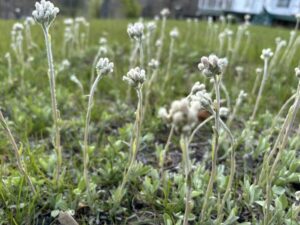
-
Blooms stand up several inches.
-
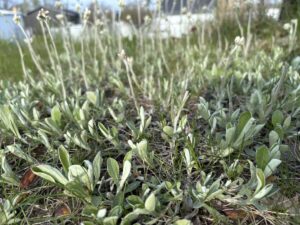
-
Field Pussytoes hug the ground
by Winding Pathways | Apr 18, 2024 | (Sub)Urban Homesteading, Garden/Yard, Garden/Yard
Spring Ritual
After this weird winter, most of us in North America are simply ready for spring and want to get outside. Some folks take initiative and start garden and flower seeds indoors then transfer them outside when the weather moderates.
Are you ready to work the land? Try something new: No-till Gardening.

A rite of spring.
For generations, an April ritual all across the northern hemisphere is pulling the spading fork out of storage and firing up the rototiller. For generations, gardeners have learned from mentors, books, and videos that tilling is essential to create an abundant harvest of tomatoes, peas, beans, carrots, and so many other delicious garden vegetables.
Over decades and diligent research, we have learned that tilling is often just extra work that might harm the soil! Try no-till gardening.
Science Writer Shares Information
We recently heard science writer, author, and land steward Connie Mutel speak about how Iowa’s amazingly productive topsoil is being degraded by annual plowing and otherwise disturbing the soil. Mechanically mixing soil bares the soil to the air, where it oxygenates, leaching carbon into the atmosphere. When winds blow or rains fall, bare soil erodes. Waterways become contaminated and silt washes downstream eventually to the Mississippi Delta resulting in damage to commercial fisheries and wildlife there. According to Mutel, half of Iowa’s once 16-inch veneer of topsoil has been lost by tillage. For much more information check out her books available at the University of Iowa Press-uipress@uiowa.edu.
Reduce Runoff and Work
Most people aren’t farmers but many of us have backyard gardens. An annual activity is tilling. For years we followed conventional wisdom and used our trusty spading fork to turn over the soil each spring. Not so much anymore.
Last year encouraged by Drew Erickson, Farm Manager, of the Rodale Institute’s Midwest Organic Center, we left about half the garden untilled. “Tilling disrupts the organisms that make soil healthy and productive. “Try no-till gardening. Just plant your seeds in untilled soil,” he advised.
Last spring we tilled half the garden, smoothed out the soil, and planted our seeds.
We didn’t till the other half and just planted the seeds directly into the soil. A few months later we harvested at least as many vegetables from the no-tilled areas as the tilled……and we’d avoided the pitchfork work.
-
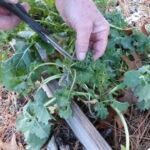
-
We planted kale directly into the ground with good results.
-
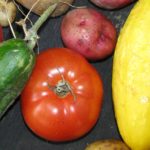
-
Summertime meal from the garden.
This year we’ll only till about a quarter of our garden. Into the rest we’ll plant our seeds and spread a layer of compost directly on the soil surface after the sprouts emerge.
We’re counting on bountiful harvests of many vegetables.
Join the Project
Give it a try. Put onion and potato sets, tomato plants, and bean seeds directly into the untilled garden soil. Let us know the results.
Learn More
Rodale Midwest is holding a free field day to show the value of minimum tillage and cover crops. It’s geared for farmers but gardeners are welcome. To register for the July 9, 2024, workshop go to the Rodale Institute Midwest Organic Center.
Have fun in the garden and enjoy a season of delicious vegetables.
by Winding Pathways | Apr 4, 2024 | (Sub)Urban Homesteading, Garden/Yard, Pests
Easy Peasy Life for Ticks
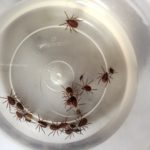
Collection of ticks
The recent warm winter was easy on heating bills and back muscles used to shovel snow, but it may mark an early return of Lyme Disease and the ticks that spread it.
At Winding Pathways we take a multi-pronged approach to reducing the odds of being bitten by an infected tick. Here’s great news! A new way to reduce Lyme Disease in white-footed mice is emerging which is good news for human health.
It was once believed that whitetail deer were the primary carriers of Lyme Disease with the theory that an infected tick leaves a deer and bites a human. Deer can carry Lyme Disease and pets and other wild animals can get it, but new research shows that white-footed (or deer) mice are the major carrier. Those tiny rodents are abundant where people live.
Old Standby Ways To Protect Against Lyme Disease
For many years we’ve done several things to lessen the chance that an infected tick will bite us.
First, we use repellents, even when working in the garden or enjoying a backyard barbeque. Deet-based repellents are widely available and repel ticks, mosquitoes, and even pesky flies. Deet can be applied to the skin. Permethrin is fatal to ticks and shouldn’t be applied to the skin. Spraying it on clothing makes life challenging for any tick seeking a human blood meal.
In recent years we’ve bought clothing from the Insect Shield Company. It is permeated with permethrin. Their clothing is stylish, comfortable, and durable, so we invested in several sets. In winter those clothes are stowed in the attic but worn daily during months when ticks are on the prowl.
Permethrin is sold in spray containers and it’s easy to treat jeans, shirts, socks, and shoes without needing to buy specially treated clothing. The chemical remains in clothing through several washings.
Second, we always do a tick check after being outside. Ticks typically walk around on a person for a few hours seeking a warm spot with thin skin to best extract blood. An unattached tick won’t spread disease, so after being outside we shed clothes, put them in the washing machine, take a warm sudsy shower, and check our bodies for ticks. They’re most likely to lurk in warm moist body parts but can be anywhere.
-

-
Pants, boots, varied sprays can reduce odds of picking up ticks
-
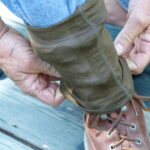
-
gaiters with tick guard helps repel ticks.
-

-
Pants, shirts, and socks infused with permethrin appear to keep ticks off.
New Promising Way to Reduce Lyme Disease
Relatively new research links the incidence of Lyme Disease with the presence of white-footed mice. Before we knew this we were already doing the right thing by encouraging mouse predators to live on our property. We love spotting hawks wheel overhead and hearing the chilling calls of nighttime owls. Both feast on mice. So do foxes, many snake species, and coyotes. Domestic cats also do but they kill many birds, so we are a catless family.
US Biologic is introducing a new way to reduce the odds a human will contract Lyme Disease from a tick that had bitten an infected mouse. They’ve been working on its development for 20 years, and it’s becoming available through pest control companies in many states.
Lyme Shield
It’s called the LymeShield System which combines traditional tick control with Lyme vaccine-coated pellets in a timed application dispenser. It doesn’t kill the mouse or any predator that might catch and eat it. A tick that bites an inoculated mouse will not pick up the Lyme bacteria. So, if that tick then bites a human it will not transfer the disease. The home page has a fascinating map that shows the progressive spread of Lyme disease.
US Biologic has come up with a clever way to help protect a family from Lyme Disease. We’re going to try it when it’s available in Iowa but we’ll keep using Deet and Pyrethrin and doing tick checks after being outside. We’ll also keep saying “thanks” to our predator neighbors that are constantly on the prowl for mice meals.
Being outdoors is amazingly good for human health. Playing ball, fishing, gardening, grilling, and even just sitting in a lawn chair offer healthy fresh air and sunshine. Fear of contracting Lyme Disease encouraged many people to stay indoors. Winding Pathways urges them to take tick precautions but spend as much time as possible outside.
Go outside and have fun.
by Winding Pathways | Mar 21, 2024 | Garden/Yard, Garden/Yard, Trees
Bright! Beautiful! Ominous!
As we walked across a New Jersey parking lot last summer an amazingly colorful, and new-to-us, insect fluttered in front of us. It had a gorgeous creamy white and bright red body covered with black spots.
Identifying it was easy and ominous. It was a Spotted Lanternfly. First found in Pennsylvania in 2014 it likely came to the United States from its native China as a hitchhiker in a crate or box.
It may be a pretty bug but its presence is ominous. It feeds on at least 172 different plant species and is spreading rapidly westward from its start close to the Atlantic Ocean.
Feeding off Another Invasive
What’s somewhat ironic about the lanternfly is the insect’s affinity for another Chinese invasive, the Tree of Heaven or Ailanthus. Although the inch-long insect will eat many different plants it prefers this highly aggressive and fast-growing tree.
Important Contact Information
The Iowa Department of Agriculture and Land Stewardship is on the lookout for the Spotted Lanternfly. They ask anyone spotting one in Iowa to report it by calling:
l (515)725-1470 or logging onto their website at IowaAgriculture.gov.
How To Reduce the Invasion
A key to reducing this insect’s abundance may be reducing Ailanthus tree numbers. This invasive tree thrives in urban and rural areas, often forming large groves. It displaces native trees, has little commercial value, and now harbors an introduced insect pest.
Winding Pathways encourages anyone with an Ailanthus in their yard to remove it, convert it to firewood if you can, and replace it with a native tree species. Remember, report any Spotted Lanternflies you spot.
-
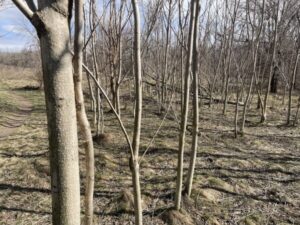
-
Grove of young Ailanthus.
-
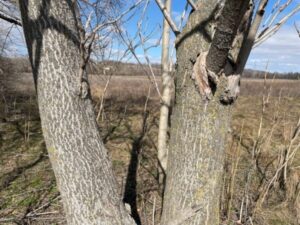
-
Ailanthus trees grow fast.
by Winding Pathways | Dec 14, 2023 | (Sub)Urban Homesteading, Bugs, Garden/Yard, Nature, Pests
Autumn Reveals Nature’s Wonders
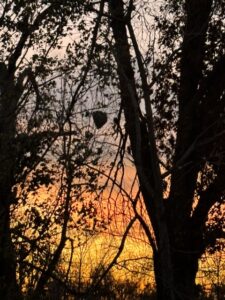
Bare trees reveal a bald-faced hornet nest.
November’s wind stripped the leaves off one of our maples and revealed a big gray football-shaped bald-faced hornet nest. Although we’d walked under it all summer, we had no clue it was there.
This fall many people will discover similar “paper wasp” nests in their trees or shrubs or even tucked near a light fixture. Made of a paper-like material, the nest was really made by insects called “bald-faced hornets” that are related to other wasps, including yellow jackets.
These social wasps can attack in droves. Their sting hurts. Because their stingers are smooth, unlike honey bees, they can sting again and again.
So, what do you do when you spot a nest on a crisp fall afternoon? Leave it alone!
Life History
The insect’s life history gives the best clue on how to avoid painful stings.
Last fall the colony of 500, or so, worker wasps died as the weather cooled. The fertile queen survived by tucking herself under a rotting log somewhere to slumber through winter. Come spring she’ll make a tiny paper-like nest, usually in a tree, and lay eggs that become workers. These hard-working new insects expand the nest and forage widely.
They are omnivores eager to dine on rotting fruit, but among their favorite foods are caterpillars and adult insects. Bald-faced hornets are a gardener’s friend, removing vegetable-chomping insects. They also sip on nectar so are good pollinators.
Aggressive or Protective?
Most sources claim they are highly aggressive, and they are if someone disturbs their nest. Several years ago, an adult neighbor spotted a nest above the doorway that the family had used all summer. He tried to knock it down and only damaged the nest. His misguided aggression unleashed an attack by dozens of upset bald-faced hornets. Stung many times, he’ll likely never again molest a nest.
We walked under and near the bald-faced hornet’s nest in our yard many times this summer and didn’t even know it was there. They didn’t attack us. Rather, they snacked on our vegetable gardens’ pests.
The lesson: leave these insects and their nest alone.
Ironically, by the time most people discover a nest in very late fall, the colony has already abandoned it. The best thing to do is NOTHING. Winter’s wind, rain, and snow will disintegrate the nest, and the queen will find a new spot to build next year’s colony.
by Winding Pathways | Oct 26, 2023 | (Sub)Urban Homesteading, Garden/Yard, Nature, Trees
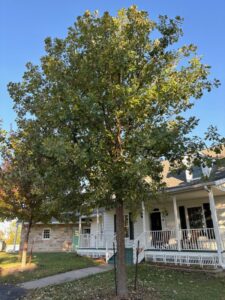
Magnet bur oak in front yard
We didn’t intend to create a magnet when we planted a skinny bur oak in our front yard 13 years ago.
It created a startling experience one October evening when Marion went to the porch to check the weather. A large furry form dropped from the nearby tree and scurried away in the gathering darkness. A woodchuck? Not likely. They work the day shift. Later we caught the mystery animal in the bean of a flashlight as it returned to the magnet tree. A husky raccoon that again retreated in haste when it saw us.
Over the next several days we watched squirrels and woodchucks forage on the acorns. At dusk bucks and does with yearlings eagerly, yet watchfully, gobbled up acorns. In between, turkeys wandered by to forage. Blue jays dropped out of the tree onto the ground and carried off husky acorns to store for winter.
Why Oaks Attract Wildlife
Our October oak was a perfect magnet. While most area oaks were acorn-bare, our youthful front yard tree was loaded with them. They were huge, sweet, and free of the weevils that often consume acorns before exiting through tiny holes.
Blue jays, wild turkeys, woodchucks, raccoons, squirrels, and deer consider October acorns prime carbohydrate-loaded food. When few oaks, scattered around, bear a heavy crop, wild animals beeline to those loaded with nuts. That’s why our tree was a magnet drawing in a stream of wildlife until every acorn was consumed.
-
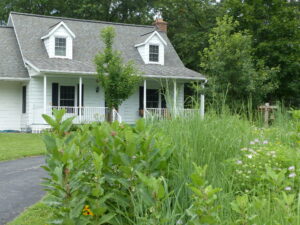
-
Small oak and maple.
-
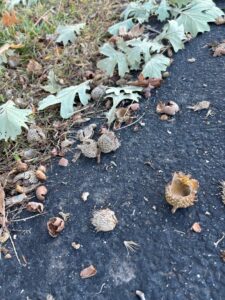
-
Prolific Bur Oak acorns
-
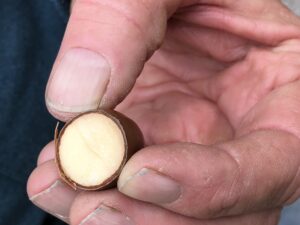
-
White oak acorns have lower tannic acid.
White oak types have leaves with rounded lobes. These include white, bur, and swamp white oaks. Their big acorns are low in tannic acid and are a prized animal and human food. Most trees only bear a heavy crop every few years with acorns that sprout almost as soon as they hit the ground. If not eaten soon weevils find them.
Black oak types have leaves with pointed lobes. Their acorns are loaded with bitter tannin. Often wild animals only feast on them after nearby sweeter white oak-type acorns have all been eaten. Black oak-type acorns wait until next spring to sprout. Perhaps their tannic acid helps them remain uneaten until they sprout months after falling from the tree.
Optimal Places to Plant Oaks
When planted in an ideal location with full sun and rich soil, an oak will begin producing acorns when it’s seven to ten years old. Our front yard tree had a light crop the past few years, but when it reached its 13th year it was loaded with nuts. It was a true magnet that lured wildlife in from far and wide. We enjoyed watching many animals dine on acorns produced by a tree we planted.
















